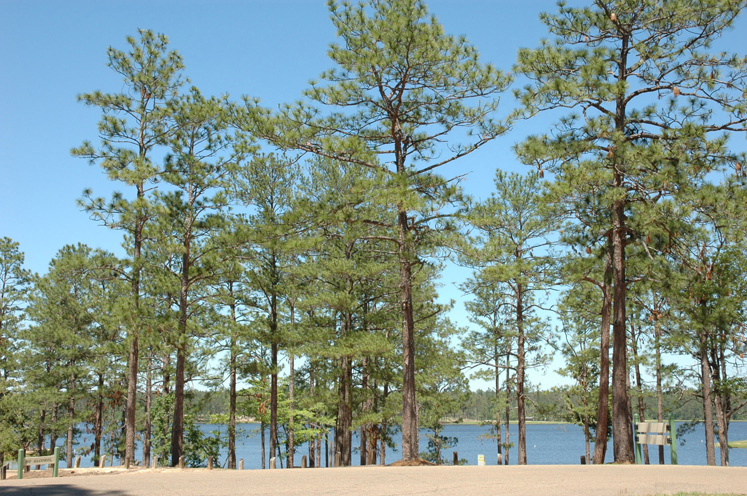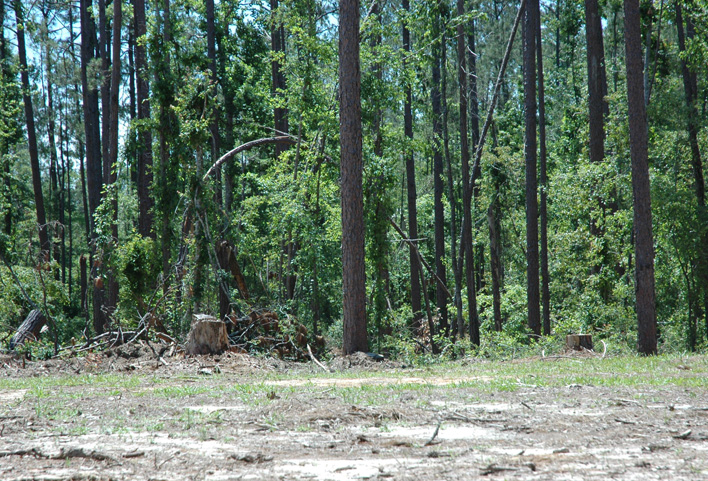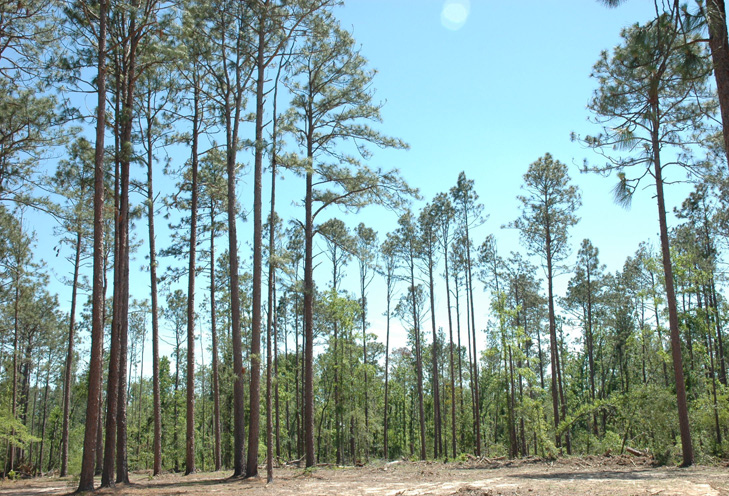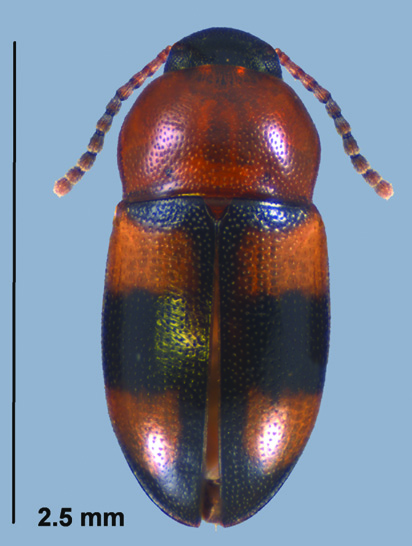Ants in Paul B. Johnson State Park, Forrest County, Mississippi, 11 May 2006 [MS State Park Ants]
Joe A. MacGown and JoVonn G. Hill
Paul B. Johnson State Park is located in Forrest County, Mississippi just fifteen miles south of Hattiesburg on Highway 49. This 850 acre park is centered around the large spring fed Lake Geiger and is surrounded by deep forests, primarily long-leaf pines, with mixed hardwoods and loblolly pines also present. The park has a nature trail, picnic areas, improved and primitive campgrounds, cabins, and many other amenities.
Unfortunately, at least for us ant collecting dudes, the park had been hit hard by Hurricane Katrina (as was pretty much everywhere else on or near the coast of Mississippi) in the fall of 2005 and there was much damage, especially to trees. In efforts to clean the park, lots of heavy machinery was used to remove damaged trees and debris. As a result, there was considerable disturbance to the park. In the ant world, disturbance generally creates a situation where introduced species may thrive, which in turn adversely affects diversity. Indeed, this was the case here, and most of the ants we collected and observed were introduced species and low species diversity was seen. For the amount of time we spent collecting here, which was comparable to most sites we collect at, the total number of species collected was very low.
Our (Joe MacGown and JoVonn Hill) collections began at approximately noon on 11 May 2006. Upon driving into the park we noticed right away that areas were more open than we had seen on a past visit to the park. Nevertheless, we wanted to see what we could find here, so we continued on to the office to talk to the manager of our plans. En route, we crossed the spillway area, where water was flowing from the lake across the roadway, which we thought was cool. When we arrived at the office the manager was quite receptive to our collecting any and all ants. He described seeing a large reddish colored ant that very morning, which we figured was C. castaneus (Latreille). We asked about a cabin too, as we were anticipating spending the night there and doing some night collecting with a blacklight and sheet setup. There wasn't anything open right away, but he thought something was about to open and that we should check back after an hour or so. Good deal.

A view of the lake from the road.
We drove around the park looking for collecting spots, while at the same time noticing the overall disturbed nature of the park. We passed through the improved camping area, which was full of RVs including many that appeared to be FEMA RVs for Hurricane Katrina evacuees. The road eventually led to a primitive campground area (31°08'01"N89°14'41"W), where we found a trail of sorts. We decided to try our luck here because there weren't any people around and it gave us easy access to a forested area. However, much of this area, as were other parts of the park, was disturbed with downed and cut trees and evidence of heavy machine activity everywhere. But, the soil was sandy and there was plenty of long-leaf pine, some short-leaf pine, southern red oak, poke berry, and a variety of other trees and shrubs present. Overall, we thought it looked like good ant habitat, despite the fact that it was such a disturbed area.

The primitive campground area.
Well, we were right about the place being good ant habitat, and we saw a multitude of ants. Unfortunately, we didn't see very many different species of ants and most of those we did see were introduced species. There was an over abundance of Argentine ants, Linepithema humile (Mayr), Brachymyrmex patagonicus Mayr, fire ants, Solenopsis invicta Buren, and Pheidole moerens Wheeler, all exotics, there. The fire ants were nesting in the soil without mounds, in piles of litter or wood chips, and under bark of dead pines on the ground. Nowhere were any of the typical fire ant mounds seen here. The Argentine ants were not totally taking over the place yet, but the fact that they were there did not bode well, as these girls can take over large areas while suppressing or forcing out many other species. They were seen nesting under logs and in hollow sticks on the ground. Pheidole moerens appears to be spreading throughout the southern portion of our state and is now very common in the region. At the park we found this species with alate females present nesting at bases of long-leaf pines and under bark of pines on the ground. A large dealate queen of Camponotus castaneus was also found at the base of a long-leaf pine. A colony of Camponotus pennsylvanicus (DeGeer) was found under bark of a dead long-leaf pine. While sifting pine litter, one worker of Strumigenys louisianae Roger was collected. Crematogaster ashmeadi Mayr and Aphaenogaster carolinensis Wheeler were collected in litter at the base a long-leaf pine tree. We collected a bag of litter from the bases of long-leaf pine trees and another sample of litter from a wet swampy area with loblolly pine and tupelo present. Unfortunately, no additional species of ants were found in the litter samples.
After collecting at the primitive campground area for about an hour, we decided we couldn't take it anymore, and we went to another part of the park. On the way into the park we had seen a nice open sandy area with scattered long-leaf pines that was adjacent to a forested area and across the road from a picnic area bordering the lake (31°08'01"N89°14'41"W). We went back to that spot to try our luck.

View of the locality across the road from the picnic area
The first thing we did was put some peanut butter on some tree trunks in hopes of turning up some arboreal species. We then starting hunting for other ant species at this site. Right away we could see that this locality was dominated by three invasive species, Brachymyrmex patagonicus, Solenopsis invicta, and Pheidole obscurithorax with lesser numbers of P. moerens present. Colonies of B. patagonicus were found at the base of virtually every pine stump we searched, as well as at bases of living pine trees and under bark of dead pines on the ground. Both male and female alates were found in colonies. It was much the same with fire ant colonies and they were everywhere with colonies seen in the soil with either low irregular mounds or simple holes for entrances, in piles of litter at bases of trees and stumps, or under bark of dead pines on the ground.
We also found several colonies of Pheidole obscurithorax Naves here. This is the biggest Pheidole species we have in Mississippi and similar to P. moerens, it appears to be making its way northward. Prior to finding this species at this park, it was only known from Jackson and George Counties, making this the most northernmost record to date. The colonies of this species were in the soil and had a mound of soil approximately 18 mm in diameter surrounding the entrance hole. Several scattered colonies were found in this area. Because these ants are so cool looking with their large major workers, we decided to observe the activities of a colony for a while. The colony we watched was near the base of a long-leaf pine tree and approximately one meter from a colony of S. invicta. The first thing we noticed was that the outside of the Pheidole mound was littered with many dead fire ant bodies. We observed individuals of the exotic tenebrionid beetle, Poecilocrypticus formicophilus Gebien, which has been reported to be associated with imported fire ants (MacGown, 2005), moving about in the piles of fire ant carcasses. This lends credence to the possibility that this beetle is a less specialized myrmecophile that is more of a scavenger in nature.

Poecilocrypticus formicophilus, dorsal view.
The fire ants did not seem to be in any way deterred by the dead bodies of their comrades and roamed freely throughout the area including in the pile of fire ant bodies. In fact, on several occasions we witnessed fire ants entering the Pheidole colony. We assumed that they were entering the colony to steal seeds or other food stores, although this was not confirmed. This practice of entering the colony was obviously risky business for the fire ants and we observed minor workers of P. obscurithorax carrying out gasters of Solenopsis workers, which they then placed on the outside of the mound with the other Solenopsis body parts. However, other than the apparently suicidal missions into the Pheidole nest, the fire ants and Pheidole appeared to have no problems coexisting in the same area and both species were seen roaming the area in apparent indifference to one another. The amicable existence between these two species suddenly changed when we introduced some peanut butter on a small stick on the ground approximately equidistant between the Pheidole and the Solenopsis colonies. Whereas previously the foragers of the two species appeared to tolerate each other, they became combatant upon finding the peanut butter bait placed in their midst. Smaller fire ant workers attacked minor workers of P. obscurithorax by grabbing a leg and tried to sting them and drag them away from the peanut butter. The fire ants appeared to be getting the best of the minor workers, but during this time the major workers had become more active and were streaming out of their colony. The fire ants also attacked the major workers, but being much larger, the majors were able to rebuff their attacks relatively easily and the battle appeared to be a stalemate. Both species were able to carry off some peanut butter. We watched one Pheidole major worker carry a large stick about twice as long as its body toward its nest from the area where the peanut butter was located, but we did not ascertain exactly what the purpose of this was. We wondered if some small quantity of peanut butter was stuck to the stick, but we could not be sure of that. After a while, we stopped watching the ants to search the area for other species. Before doing so, we dug into the Pheidole colony to collect a good series of majors and hopefully find some alates, although no alates were found. After approximately one hour, we went back to the Pheidole/Solenopsis peanut butter battleground to see if both species were still at the bait. Upon returning we found only fire ants at the bait. There could have been several reasons for this including the possibility that the fire ants finally out competed the Pheidole for the bait, the Pheidole got enough food for their immediate needs, or perhaps our disturbing the Pheidole colony forced them to return to the colony to repair the damage.
We crossed the road and collected near the bathroom, picnic area, and alongside the lake. However, we found the same species there as we did on the other side of the road. Sweeping vegetation along the lake did not yield any further species. After perusing this area for ants, we went back and checked the peanut butter bait that we had put out about an hour earlier. The only species we found at the bait was Solenopsis invicta. Big surprise there. Actually, they were quite resplendent as their golden red bodies glistened in the sun as one mass.
We collected two litter samples from this area. One sample was made from litter found between two long-leaf pines and a sassafras tree and the other sample was from litter and wood chips near pine stumps. Similar to the first site where we collected in the park, the litter samples yielded no additional ant species.
A return visit was made to the site by MacGown and Hill on 10 May 2010. Collections were made at a campsite near the lake at 31°08'48"N 89°14'47"W and on the nature trail at 31°08'09"N 89°14'03"W. Similar to the first collecting trip here, diversity was very low, and we only collected 7 species of ants. However, we did add three species to the park list including two common native species, Aphaenogaster lamellidens and Monomorium minimum, and a common exotic species, Strumigenys membranifera .
Overall, we only collected a total of 17 species of ants, which is quite low for a couple of hours of collecting in a wooded habitat. This was in part due to the disturbed nature of the park and the apparent domination of several exotic species of ants. Consequently, we decided not to spend the entire afternoon here collecting after all, and therefore opted not to spend the night. We let the manager know that we would not need the cabin and proceeded to head on to collect in the DeSoto National Forest.
List of ant species collected (arranged alphabetically by genus)
Aphaenogaster carolinensis Wheeler
Aphaenogaster lamellidens Mayr
Brachymyrmex patagonicus Mayr
Camponotus castaneus (Latreille)
Camponotus pennsylvanicus (DeGeer)
Crematogaster ashmeadi Mayr
Dorymyrmex bureni (Trager)
Hypoponera opacior (Forel)
Lasius americanus Emery
Linepithema humile (Mayr)
Monomorium minimum (Buckley)
Pheidole navigans Forel
Pheidole obscurithorax Naves
Proceratium silaceum Roger
Solenopsis invicta Buren
Strumigenys louisianae Roger
Strumigenys membranifera Emery
MacGown, J. A. 2005. A Collection of Poecilocrypticus formicophilus Gebien (Coleoptera: Tenebrionidae) from a mound of the imported fire ant hybrid, Solenopsis invicta X richteri (Hymenoptera: Formicidae) in Mississippi, USA. Entomological News 116: 367-368. [pdf]


